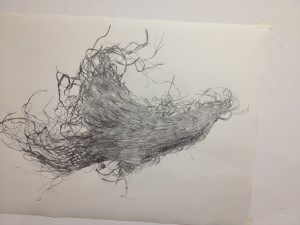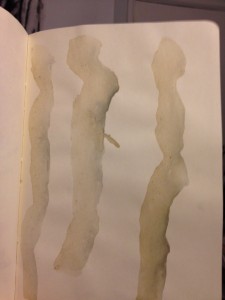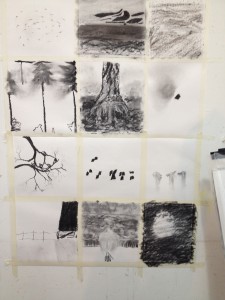
I’ve just listened to Radio 4 Start The Week for today (29 December 2014) and to Victoria Crowe, artist, who in talking about her significant place described beech trees and her relationship to the landscape:
“beech trees which describe the way the wind blows, they describe the prevailing wind by the very form of them…with the sunlight behind so you get a sense of not only this physical place but also the possibilities through looking at the light, through the distance, of this continual axis between the real and the suggested”
On Caroline Wendling’s recent course we walked a daily route through the arboretum and across the valley at West Dean, collecting thoughts, making drawings and observations and mapping experience of landscape. She mentioned in her introduction an idea of the ‘landscape of the mind’. I drew a map of the walk and included a sketch of myself holding onto a balloon cloud above me, a balloon with which the emotions within it would affect my experience of the landscape through which i walked.
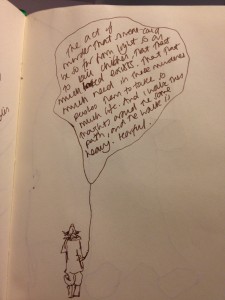
On arriving, just before I got out of my car, I heard Moira Stewart report on 150 children who had been killed by terrorists in Pakistan. Those words and the pictures in my mind and the grief I felt I then carried with me on every step of the walk. The roots of the nearest beech resembled dismembered bodies of children instead of fairytale creatures, and the beast had become manifest and real in the men who had shot through a school. The walk was heavy and tearful and it was difficult to make sense of life and death. I came across Edward James gravestone laid heavy and flat in the ground and covered in fallen leaves from the trees that had become his legacy.
On each walk I brought something different with me to the landscape, and in turn each walk offered new sights, new observations, new ideas. The ‘continual axis’ balanced the landscape of my mind with the landscape in which I was immersed.
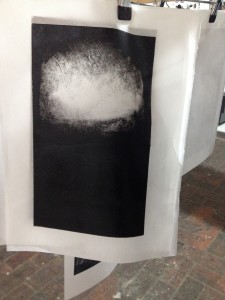
Victoria describes her practice as looking between the real and the suggested in the landscape. It is this “axis” that I consider in my practice, the bodily experience through the landscape, the thoughts, feelings and imagery I take, re-discovered through observation and assembled in the marks and words on paper. The audio recordings of these experiences are like sketches themselves. Droplets and vapours of ideas and experiences that form clouds, that get dragged around only to disappear into a digital ‘other’ world. In making the art some of these ideas are captured, and in the sharing with others offer a new way to look at the landscape, and to be in it.
